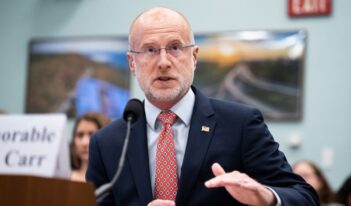
Scholar argues for an optimal commercial space regulatory regime that balances innovation, responsibility, and security.
Under its current framework for commercial space regulation, the United States may fall short in its responsibility to other nations and its own national security. In an article published in the proceedings of the 2022 Advanced Maui Optical and Space Surveillance Technologies Conference, John S. Goehring, Department of Defense national security attorney and United States Air Force reserve judge advocate contends that innovation cannot on its own outweigh and eliminate those commitments and concerns.
Goehring suggests that an optimal regulatory environment not only honors innovation but adheres to the “rule of three” of policy objectives: industry growth, fidelity to international law, and national security.
Some facets of space regulation, such as commercial remote sensing, succeed in balancing the rule of three principles, according to Goehring. Other new fields, such as commercial radiofrequency (RF), are still evolving and have not yet developed an optimal regulatory environment, he explains.
Currently, the Federal Communications Commission (FCC) requires space stations or satellites to acquire licenses for “the transmission of energy or communications or signals.” The National Oceanic and Atmospheric Agency regulates commercial remote sensing and similarly requires a license to “operate a private remote sensing space system” and comply with the Land Remote Sensing Policy Act of 1992.
But new or developing commercial space activities generate gaps in these licensing schemes, according to Goehring. He explains, however, that efforts such as the 2015 U.S. Commercial Space Launch Competitiveness Act, a related 2016 Office of Science and Technology Policy report, and a White House 2020 national space policy demonstrate steps prior administrations have taken to fill this gap. These efforts identified emerging areas of commercial space activity and proposed that Congress enact a “mission authorization” framework enabling government agencies to develop “minimally burdensome, responsive, transparent, and adaptive review, authorization, and supervision processes.”
Although legislators have yet to take on this task, these continued calls to action gesture to what Goehring calls “rule of three” policies.
The first of Goehring’s “rule of three” promotes growth in the U.S. commercial space industry. The 2020 U.S. national space policy defined its goal as encouraging “private industry to facilitate the creation of new global and domestic markets,” stressing the U.S.’s commitment to fostering a commercial space industry that “advances leadership in the generation of new markets and innovation-driven entrepreneurship.” In 2021, the Biden Administration published a Space Priorities Framework putting forth its own vision for the future of space in place of the 2020 national space policy. The 2021 framework urges the development of a regulatory environment that supports the “competitive and burgeoning U.S. commercial space sector.”
Such support of growth, explains Goehring, is often associated with deregulation and the minimization of the regulatory burden on innovative new companies. Adhering to the other two policy objectives, however, will likely require greater regulation, Goehring cautions. Goehring argues that regulators must seek to balance all three objectives in designing regulatory frameworks.
The second of Goehring’s three rules, satisfying international obligations, stems from Article VI of the 1967 Outer Space Treaty. The treaty states that “the activities of non-governmental entities in outer space…shall require authorization and continuing supervision by the appropriate state party to the treaty.”
Goehring emphasizes that fulfilling international obligations is important not only because international law mandates it, but also because the United States is responsible and liable for all commercial space activity. If a private actor violates international law or causes damage to another object in space, Goehring elaborates, it would be as if the United States itself caused those errors. Goehring urges that the U.S. providing leadership in the regulation of commercial space activities will also lead to greater accountability generally, and a more sustainable and stable future for the industry.
The third of Goehring’s rule of three objectives, preserving national security, operates as regulatory policies that grant the government the “ability to impose constraints.” Goehring outlines that regulatory regimes can elect to impose these constraints in different ways. He says that some regulators may enact constraints that attach to certain capabilities, as those capabilities correlate to levels of risk; others focus on export controls to ensure “sensitive technologies” stay out of the hands of foreign actors.
Goehring then demonstrates how the regulatory environment of commercial remote sensing effectively balances all three principles.
In 2018, the White House issued a space policy directive to spur the revision of regulations that were bolstering national security at the expense of industry growth. This policy initiative culminated in a 2020 final rule issued by the National Oceanic and Atmospheric Agency revising the remote sensing licensing regime. Under the new rule, Goehring explains, the agency now issues one-year renewable licenses reflecting tiers of capability compared to existing technology rather than issuing permanent licenses with burdensome requirements categorized by security risk. As a result, licensing has become less burdensome on companies pursuing growth, making American entities more competitive compared to foreign companies that faced fewer stringent regulations, according to Goehring. He explains that this has shifted the burden of security risk from the private sector to the government.
In contrast, Goehring claims that the commercial RF industry does not adhere to all three policy objectives, favoring growth over international obligations and national security. Because commercial RF activities pick up sounds rather than images as commercial remote sensors do, they are not subject to the licensing requirements of the Land Remote Sensing Policy Act. FCC licensing requirements only apply to the activities of launch and the signaling required for communication, but “what is collected and how it is collected is not subject to oversight.”
As such, Goehring maintains that the United States is not fulfilling its obligation to “authorize and supervise” this commercial space activity and that RF’s capability in detecting and depicting human activities on earth may pose a security risk. This risk is particularly important when the developing technology has vast military capabilities, Goehring cautions. An RF company called Hawkeye360, for example, was able to detect impending Russian military activity and its location prior to the invasion of Ukraine in February 2022.
Going forward, Goehring recommends that regulators seek to balance all three policy objectives of promoting growth, fulfilling international obligations, and preserving national security to ensure an optimal regulatory environment.



